Flying from Luxembourg to Saint Petesburg on Cessna 172
TL;DR We flew from Luxembourg to Saint Petersburg, Russia and back on Cessna 172.
Every year our Luxembourgish aero club, Aéro-Sport asbl, organizes various fly outs across Europe and diverse long distance rallies. There is annual event called Hans Gutmann Memorial Rally — a tribute to famous Austrian aviator, Hans Gutmann, who organized so many long-range trips in the previous decades, built his own airplanes and circumnavigated the world twice. He crashed in Apls in 2011.
In August 2016 we were flying from Luxembourg to Georgia, via Turkey, and back. Over 10 airplanes, mostly single-engine types, reached Tbilisi, Georgia and made this event a success. After our fortunate tour to Georgia we decided to fly via Nordic and Baltic countries to Saint Petersburg, Russia. It is a notable museum-like city, mostly popular in June during its “White Nights” season. The idea was quite challenging due to certain obstacles related to Russian regulations (or lack of them!) regarding GA at large and access of foreign GA Pilots into Russian airspace in particular.
In November 2016 we started our planning from assessment of the costs of getting the Russian over-flight permit. One thing we knew for sure: foreign registered aircraft is allowed to fly IFR only according to Russian AIP. But we wanted VFR. I’ve got several quotations from different agencies; proposed costs were from €300 to €2000 per permit, in each case Pulkovo handling cost excluded. This was absolutely too much for us, so we decided to do get the necessary permits ourselves; just like we did it for Georgia trip.
We contacted Russian AOPA and engaged Pulkovo directly. We were told that VFR is fine. To obtain overflight permit, it was required to provide a pilot license, ARC, CoA, CoR, noise certificate, insurance (covering Russia) as well as “Forma-N” request to Russian CAA (via ASTN).
Slot reservation in Pulkovo was also required. We filed all these documents via Russian AOPA for one of our LX-registered airplanes. Three or four weeks later we received a conditional confirmation that becomes valid solely upon receipt of a slot. Interesting enough, we filed the similar requests for internal flights (ULLI Saint Petersburg > ULLK Novgorod > ULLO Pskov ) and got approval as well.
Negotiations with Pulkovo took a lot of time and effort. For the sake of brevity I’d skip the details and make the story short. Pulkovo is a big and busy international airport. We needed a parking for 3 days. Local minimum handling price was ~€450 for sub-10 ton aircraft. Usually they require deposit/prepayment (in rubles). At the end of the day our friends from S7 Airlines (whose owner is a great fan of GA) helped us to arrange the handling. After long and wearying negotiations we managed to reduce the price and ended up paying ~€350 per aircraft for landing, handling and three days of parking at Pulkovo. There was also an additional charge for Russian aero-navigation services ~€35 per aircraft.
The final route was: ELLX Luxembourg — EKAH Aarhus (rally start) — ENBO Bodo (the northmost) — EFHF Helsinki Malmi — ULLI Saint Petersburg — EETN Tallinn — EEKA Saaremaa — EYKA Kaunas — EPGD Gdansk — ELLX Luxembourg.
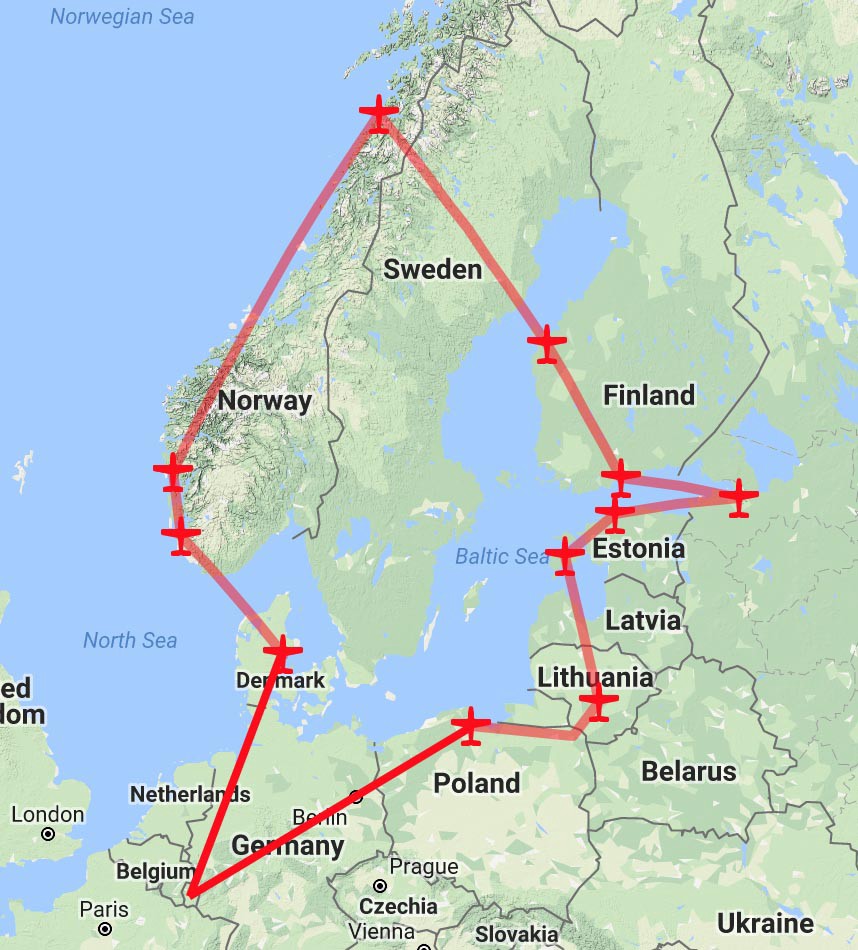
The route
The rally starting point was Luxembourg, or a home base for other non-Luxembourg participants. First meeting point was agreed to be at Aarhus, Denmark (the European Culture Capital of 2014). Pilots were expected to gather on 15th of June 2017. We were expected to arrive to Saint Petersburg on 18th, and on 25th the rally was supposed to finish in Gdansk, Poland where one of our organizers arranged a meeting with President Lech Walesa.
All was set for the rally but suddenly, just like it happened in 2016, we received a NOTAM prohibiting all flights in several Russian cities for FIFA Confederation Cup. We knew about the World Economic Forum (Russian analogue of Davos gathering), which takes place also in June, and we specifically planned the arrival after the Forum. But FIFA competition completely dropped out of our memory; so this NOTAM turned out to be a real problem.
We had a Plan B in case we wouldn’t make it to Pulkovo — to park airplanes at Helsinki Malmi airport and take a high-speed train to Saint Petersburg. Luckily shortly before our rally Russian AOPA arranged with Russian aviation authorities a special permission for our rally members to go despite the NOTAM.
Our initial plan also included Minsk, Belarus. Few months prior to start date I sent an enquiry letter to Minsk International Airport and received a rejection with reasons like “high occupancy”, etc. In other words they didn’t want to bother.
Initially 14 airplanes signed up for the trip but some dropped out for various reasons and only 9 got to the rally.
Table of Contents
- June 15 - Luxembourg, Denmark
- June 16 - Denmark, Norway
- June 17 - Norway, Finland
- June 18 - Finland, Russia
- June 21 - Russia, Estonia
- June 22 - Estonia, Poland
- June 23 - Poland, Germany, Luxembourg
June 15, day one
Luxembourg ELLX to Aarhus EKAH:
Our airplane (C172SP with G1000) was fresh out of maintenance, so we packed our stuff and departed ELLX early.
The weather was CAVOK and our flight to Aarhus, Denmark was quite a cakewalk.
(EMBED https://www.youtube.com/watch?v=Xtl6Zi1a6Ys&t=10s)
Approaching Aarhus, we were delighted to find 3 aircraft with LX registration on Flightradar in the area.
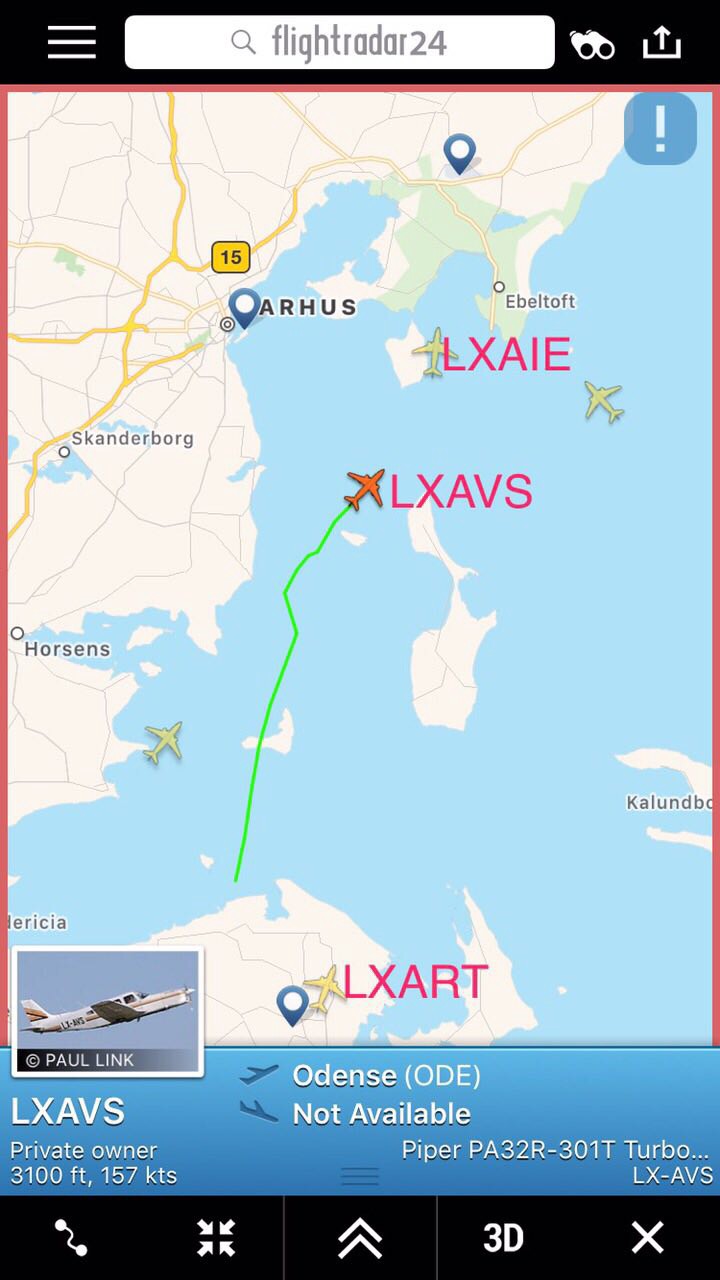
When we landed we were delighted to see 7 of our airplanes already on apron. So it was a reunion with our friends we hadn’t seen since our trip to Georgia.
We refueled (€2.6/l), paid ca. €18 for parking and headed to the city. After checking in at our hotel we gathered for a flight briefing. We already had a confirmed permit to enter Russian airspace (as well as slot assignments) and we discussed how to fill the flight plans to Pulkovo — one of our crews (Pilatus PC12) decided to fly IFR and the rest were flying VFR. After briefing, we went to a restaurant for a welcome dinner. We enjoyed our first white night.
June 16, day two
Aarhus EKAH to Bodo ENBO via Roros ENRO
We checked out, avoided quite expensive taxi (€100; there is no Uber in Denmark), caught a bus and rushed to the airport. The plan was to fly from EKAH to Bodo (ENBO) with a fuel stop at Roros (ENRO).
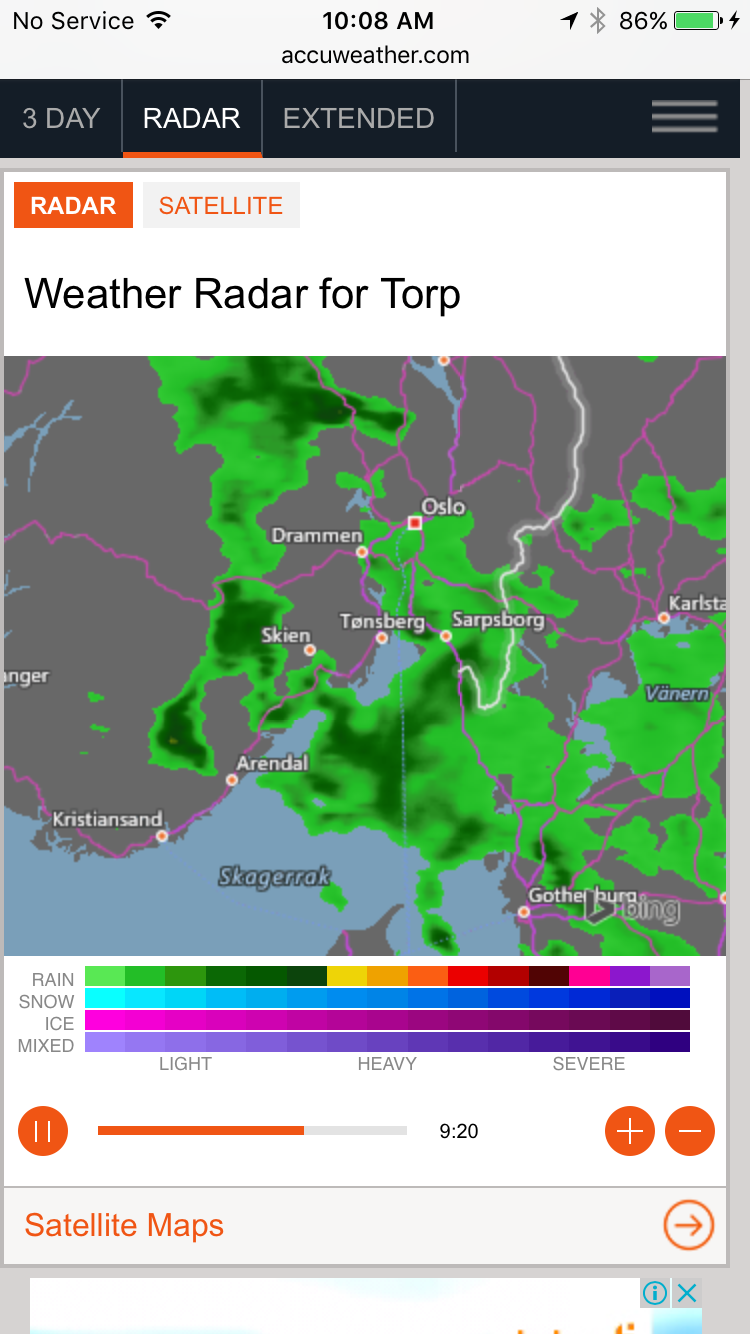
Not good
The weather started to become complicated in Northern Scandinavia: few clouds at 2000', broken layer at 5000' and rain. Crossing the Skagerrak strait clouds turned into multilayered system.
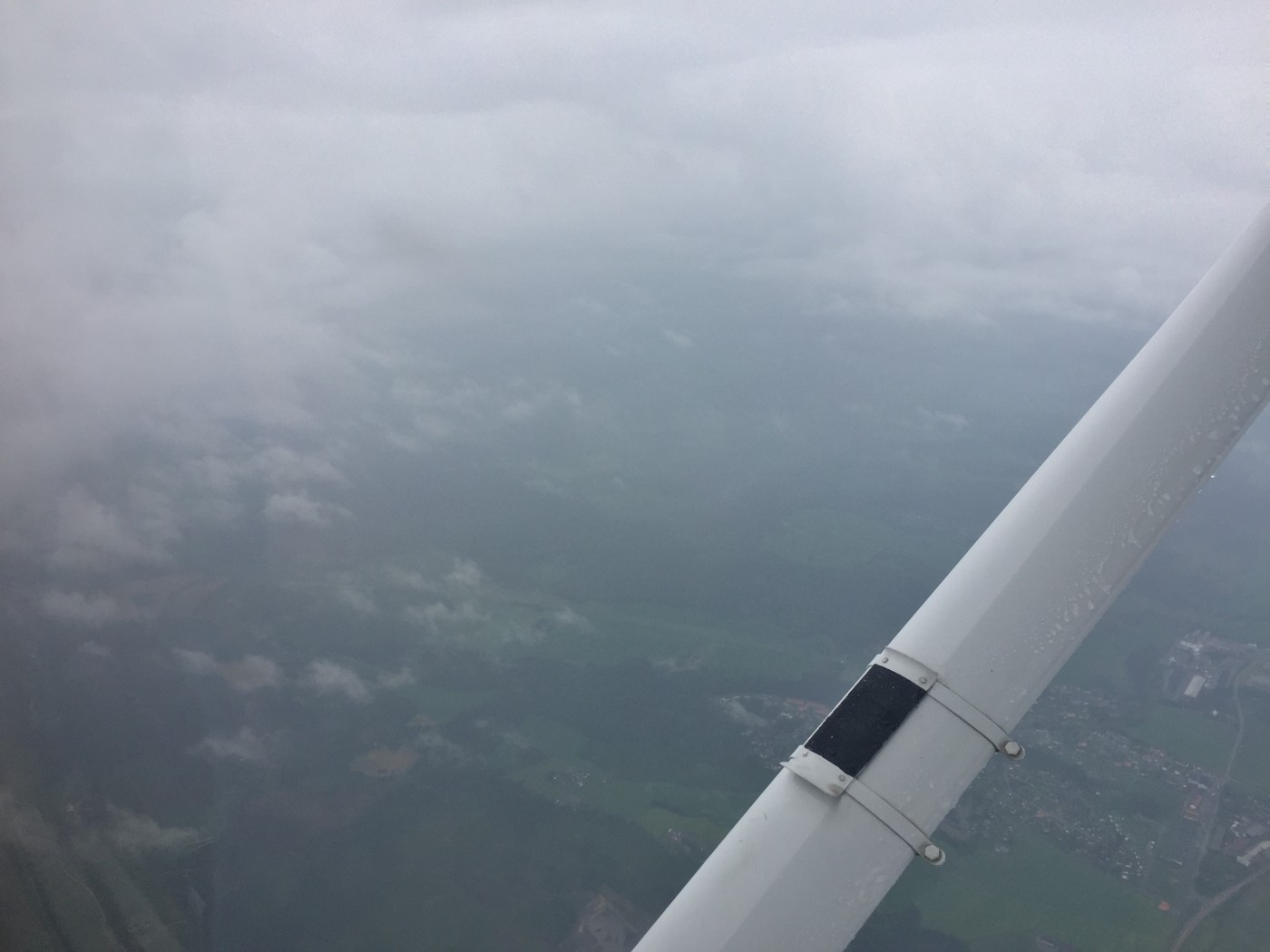
Freezing conditions prevented us from climbing. Flying at the bottom of scattered layer we saw a freezing water droplets on the wing struts. We started to hear static on our radio from ice crystals.

Passing by Oslo the weather became a little better: a little of rain, no freezing conditions. We proceeded to ENRO to refuel. ENRO controller told us to hold on while he was trying to scare the birds out of runway.
(Embed Roros approach https://www.youtube.com/watch?v=Cvem5gbDBUg)
It turned our to be quite a nice airport with friendly staff. After refueling (ca. 16NOK/l; they do not accept neither Euro nor credit cards), we decided to proceed to Bodo ASAP because of weather system developing and moving from the south.
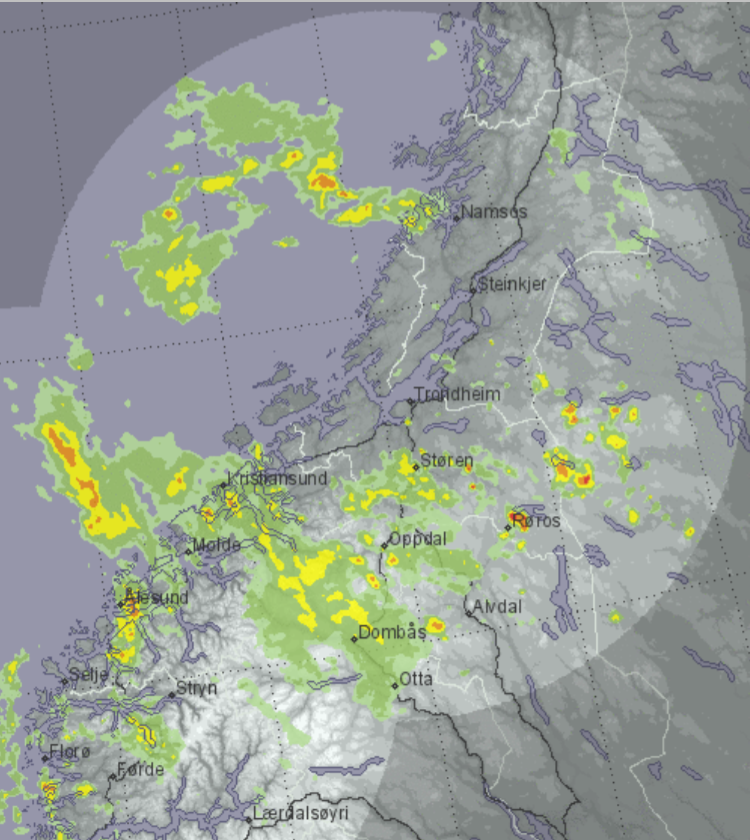
We took of in light rain, headed northwest (~25NM) to keep clear of clouds and precipitation, then direct to Trondheim, Norway then direct to Bodo across the coastline and fjords. The views were magnificent. Sunshine lit up the beautiful islands with small fjords cut in the western coast of Norway.
(Embed Roros to Bodo https://www.youtube.com/watch?v=qzVTed4Y-PA)
Flying over the fjords
We stayed at ~5000' and the snow-covered mountains that guard the fjords reminded us of the higher latitudes we were reaching.
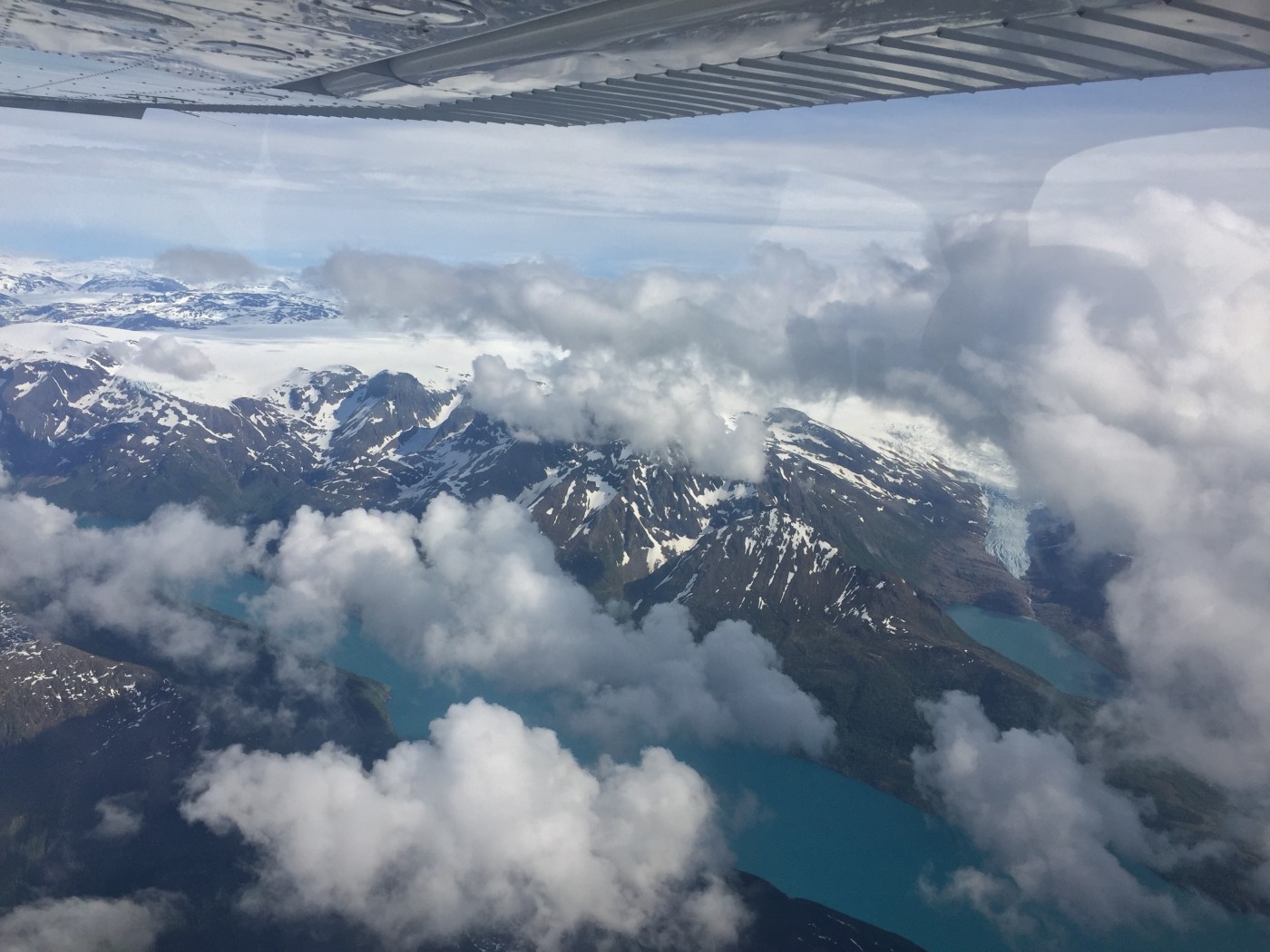
Surprisingly 3G Data worked very well in Norway at these altitudes. Never ever had we encountered such a good coverage during our trip, except for in Norway.
We landed at Bodo and refueled. The major hotels are within walking distance from the airport. We had a beer and locally farmed Norwegian salmon. Looked like the sun never settled that day.
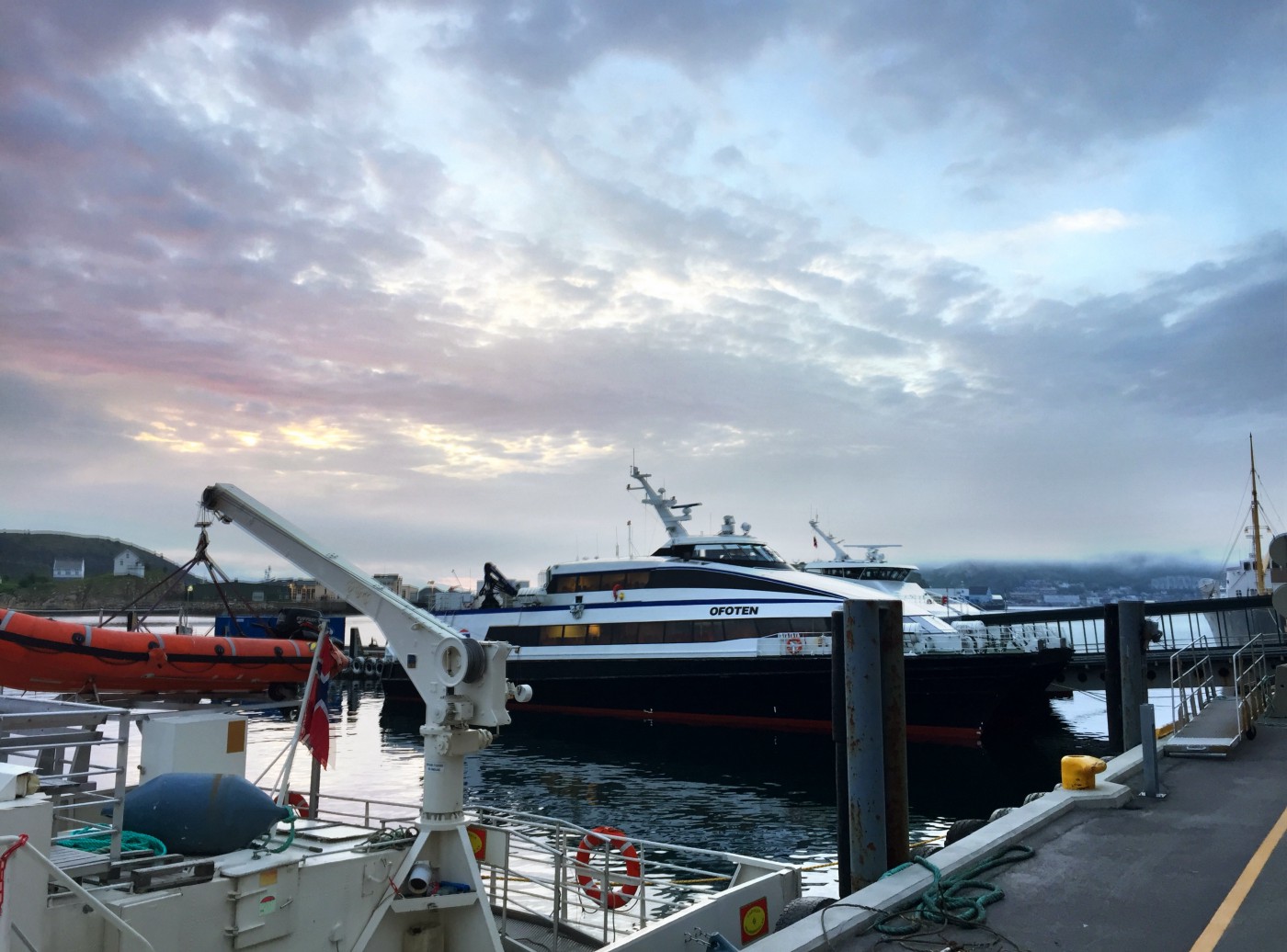
00:30 AM
June 17, day three
Bodo ENBO to Helsinki EFHF
Got up at 7 am. The weather was quite bad: mist, 500' ceiling, pouring rain. A new low frontal system had reached the Norwegian coast. The ceiling covered the hills surrounding Bodo.
Since none in our crew had instrumental rating, our aircraft was grounded.

Grounded
Sitting there in our Cessna we were watching our fellow rally members departing one by one on IFR. The tower told us that they wouldn’t let our airplane to depart in those conditions. We returned to the airport terminal and started to consider our options.
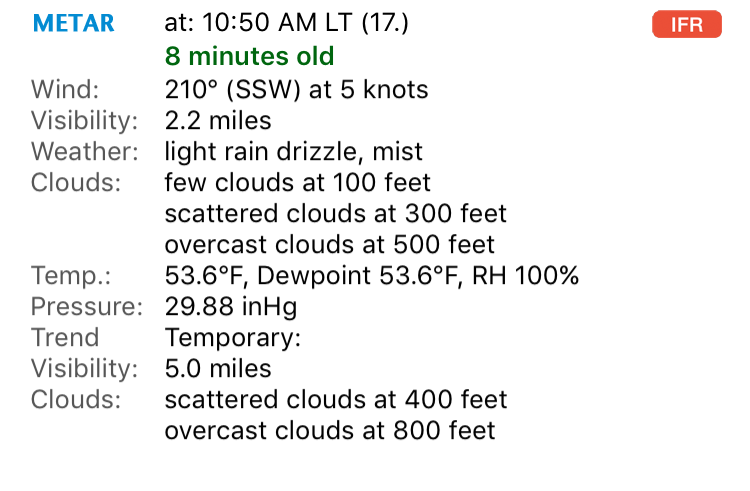
The next day at ~8AM our group ought to depart from Helsinki and to proceed to Saintt Petersburg. A Russian speaking person aboard one of our planes would’ve helped to clear it across Russian border. And there was one, Elena, who departed with the group. I started to draft an email detailing the procedures of crossing the border, waypoints and communications. I would delegate to Elena our event organizer duties; this was one of numerous “Plans B” in case we had to spend a night at Bodo.
Meanwhile we were checking weather radars and receiving PIREPs via our WhatsApp group we had created for all our crews.
Around ENBO:
- first layer 1500 to 4500
- next around 7000
- temp 0 at FL075Looked like that southwest of ENBO the weather was much better. The clouds and mist were local to the field. All we needed to do is to depart — we had ~1hr spacing between two weather systems.
We called the tower and around 2PM LT they said that ENBR became MVFR and we were OK to depart on SVFR clearance. We rushed to our airplane and departed. We had to stay ~1500' for horizontal visibility and to avoid rocks in fjords (we were lucky having G1000 with recent terrain!). We found an opening, stayed clear of clouds, climbed to 7000' and proceeded directly to Helsinki.
We wanted to climb but the temperature was 0C at 7500–8000 and we didn’t want to cool the airplane down in case we ought to return to Bodo (our alternative); so we descended via scattered layers.
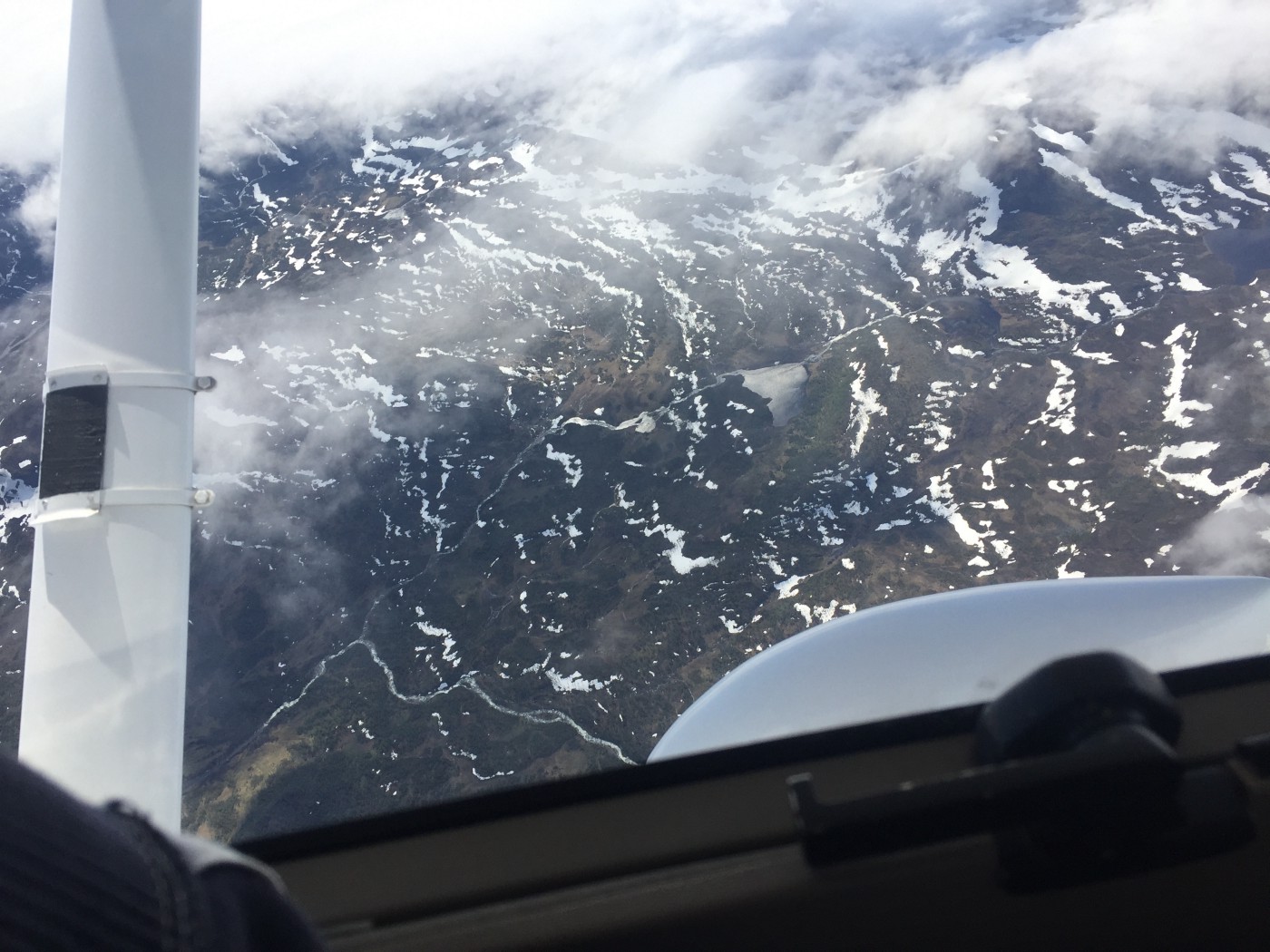
Altitude is your friend
Got some tailwind so decided to proceed directly to Helsinki, avoiding the fuel stop at ESNS (Sweden). Actually we had enough range to reach Saint Petersburg even with 45 min reserve! That was our longest leg, over 550 NM, approximately 5 1/2 hours.
By the way, to land at Helsinki Malmi a PPR (Prior Permission Request) is mandatory. It was quite annoying because the web form had been broken. We had to call them while airborne.
We landed and paid ~€450 to top up our tanks (142 liters). Burned 38 gallons for slightly over 500NM, not bad. Paid ca. €50 for landing and handling.
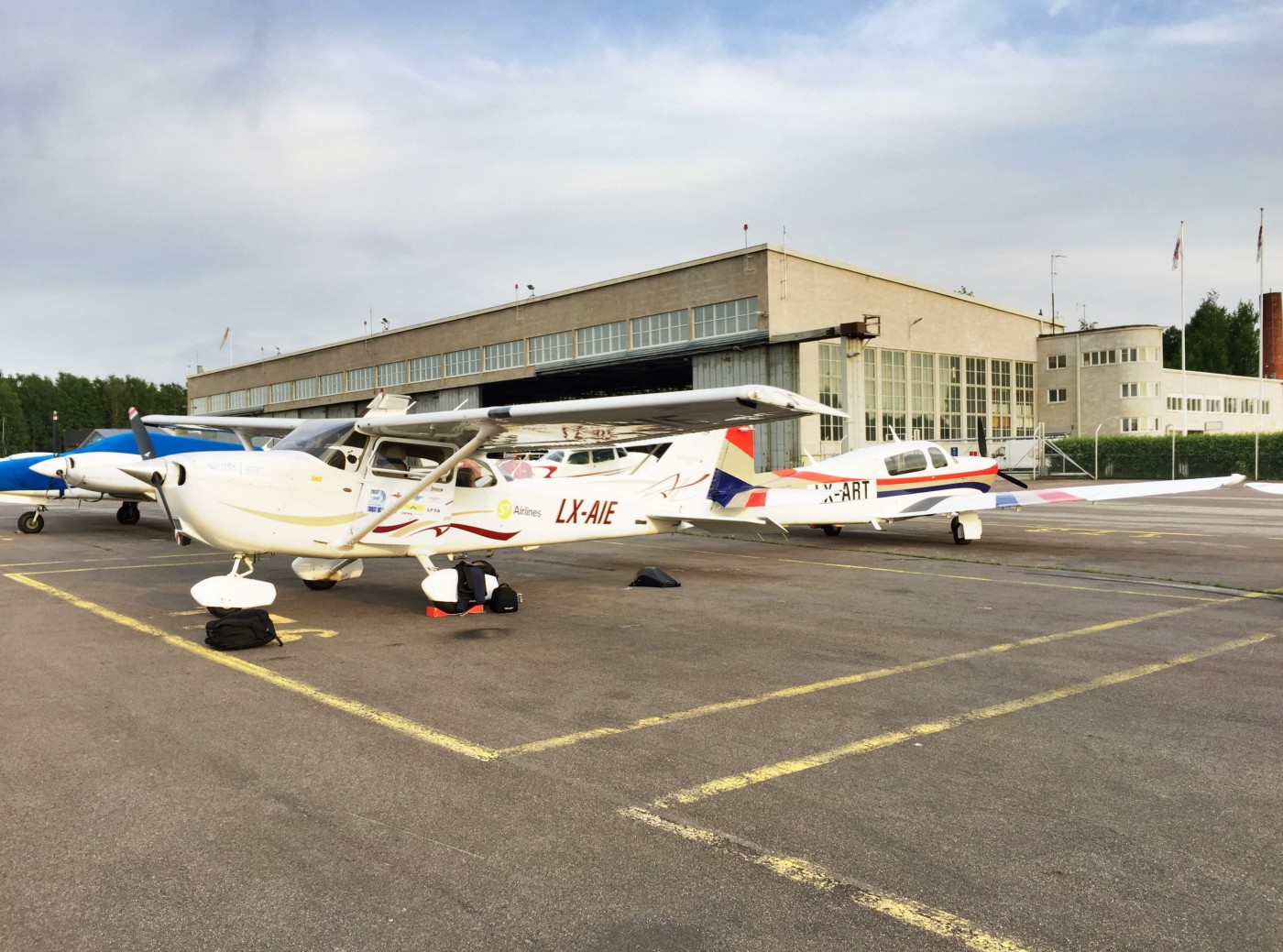
Helsinki Malmi
Finally we received a confirmation that all flight plans to Russia were accepted. It was quite a day!
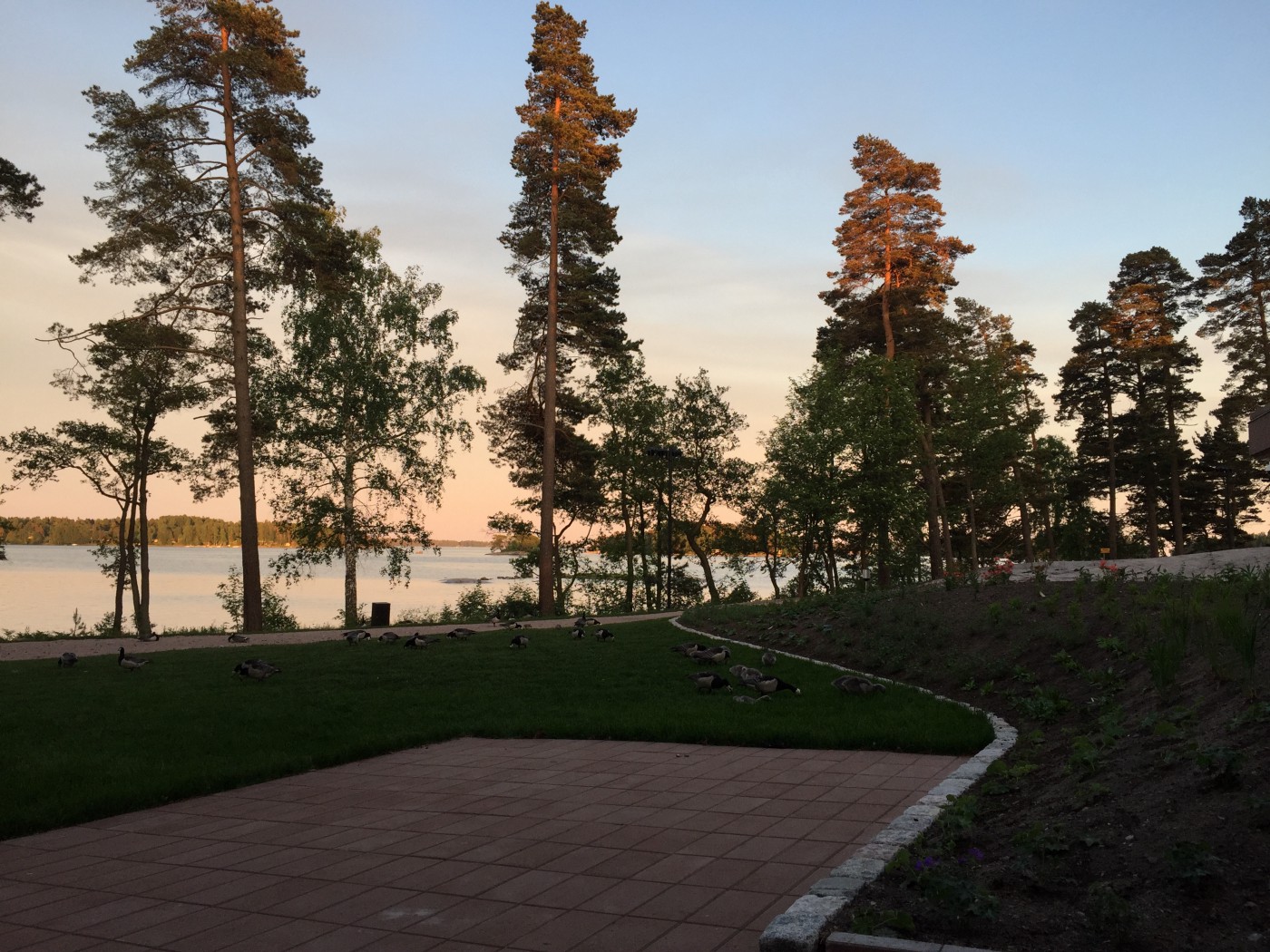
White nights
June 18, day four
Helsinki EFHF to Pulkovo ULLI
During the breakfast we received a call from the airport that local customs guys were about to leave. Apparently we mixed up the appointment time. So we rushed to the airport where we realized that one of our crews PIC forgot his passport at home (which fact did not allow him to enter Russian territory), another crew had limited license; so we engaged a Plan B for them both and they had to stay in Helsinki. The group of 7 airplanes departed bound to Saint Petersburg.
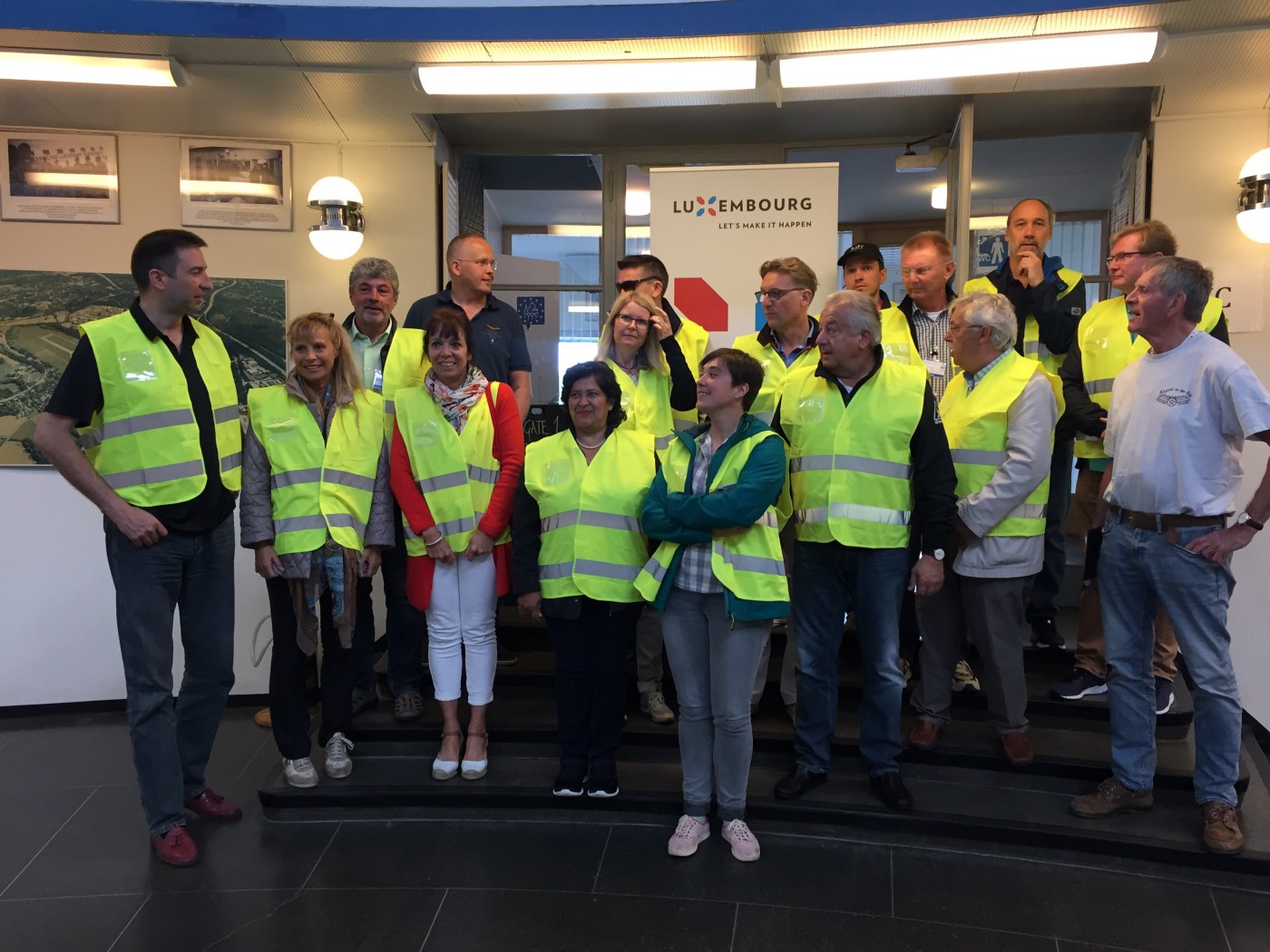
Our team
In 1987, the Helsinki-Malmi Airport was the starting point for an unauthorized flight to Russia by Mathias Rust. Since it was not our plan to follow his adventure, we were required to fly a specific route (EFHF-EFKY-ARLOM-RATLA-ARDIG-VEKIL-KEBUL-LUNOK-POGUD-BULIL-ULLI), entering Russian airspace via RATLA, and follow the rules:
1) For VFR flights, fly at 2000’ or below and request clearance from Russian ATC (“Pulkovo Rayon”) before entering RATLA;
2) Pilots must report ETE to the next waypoints (probably due to lack of radar coverage);
3) Prior to entering ULLI CTR pilots must hold on visual orbiting point for landing sequence;
4) Prior departure from EFHF over phone communication with Pulkovo-Rayon we were assigned with RWY 28R and Apron 3 for parking; the crews were expecting corresponding taxi instructions.Moreover, our slot assignment at Saint Petersburg was ~ 45 minutes with 5 min spacing between each aircraft.
We departed, slowest aircraft (meaning our Cessna) first and proceeded to RATLA. We contacted the “Pulkovo Rayon” (AKA low-altitude) controller. Radio reception was quite bad at 2000' and Rayon controller was overwhelmed. All our group (except Pilatus that went IFR) converged almost simultaneously at Russian border. Those who stayed at 1000' were lacking radio reception. Our crew, both native Russian speakers, relayed reports, clearances, assigned flight levels between our pilots to Rayon controller and back.
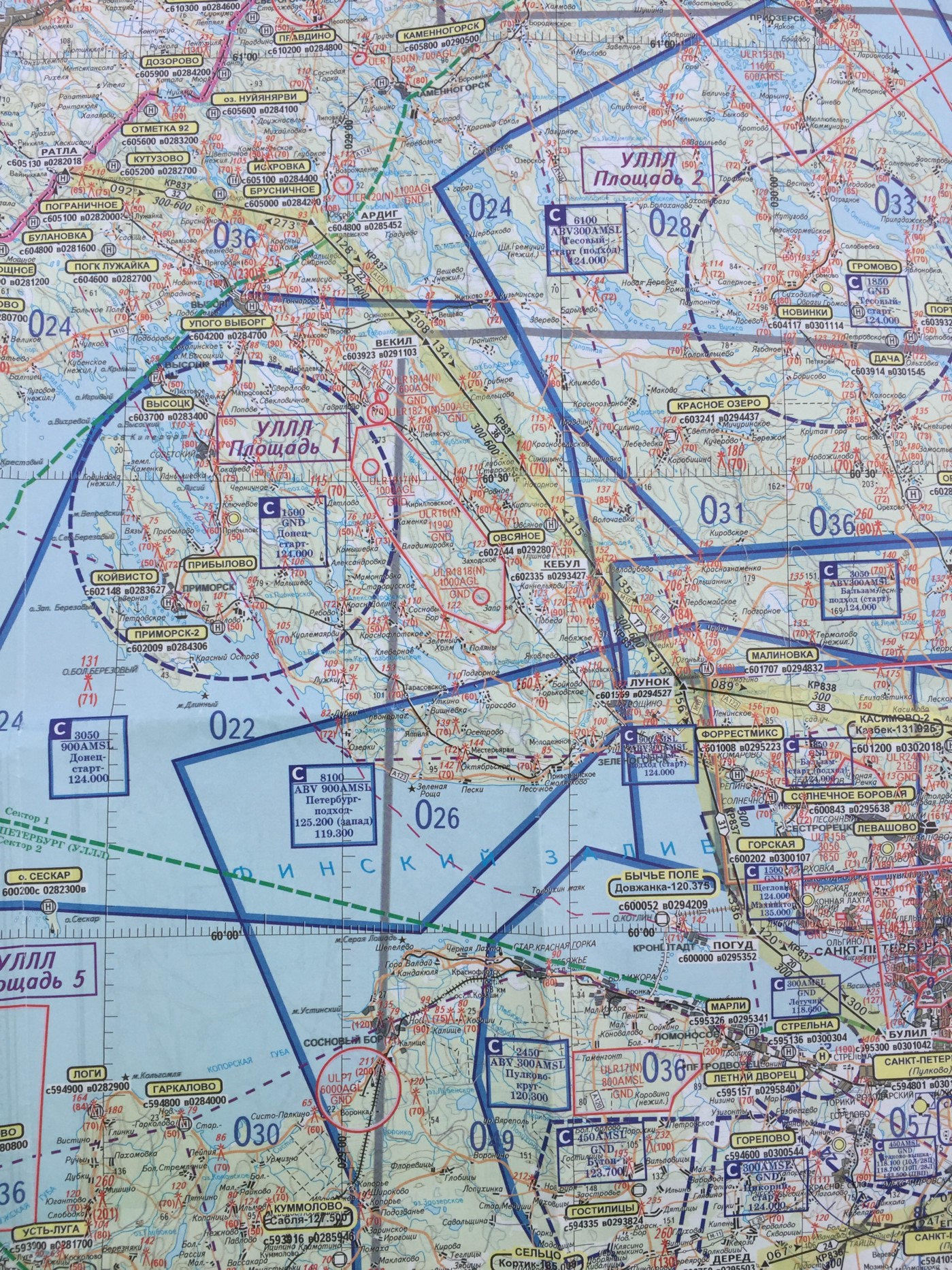
Все на русском
Finally all group cleared the Russian border. Flying via the assigned waypoints, every time we had to report ETA to the next waypoint. Looks like there is no low altitude radar capabilities (at least civil ones!).
We proceeded over the Gulf of Finland, via Kronstadt, descending and reached Saint Petersburg 1000' AGL.
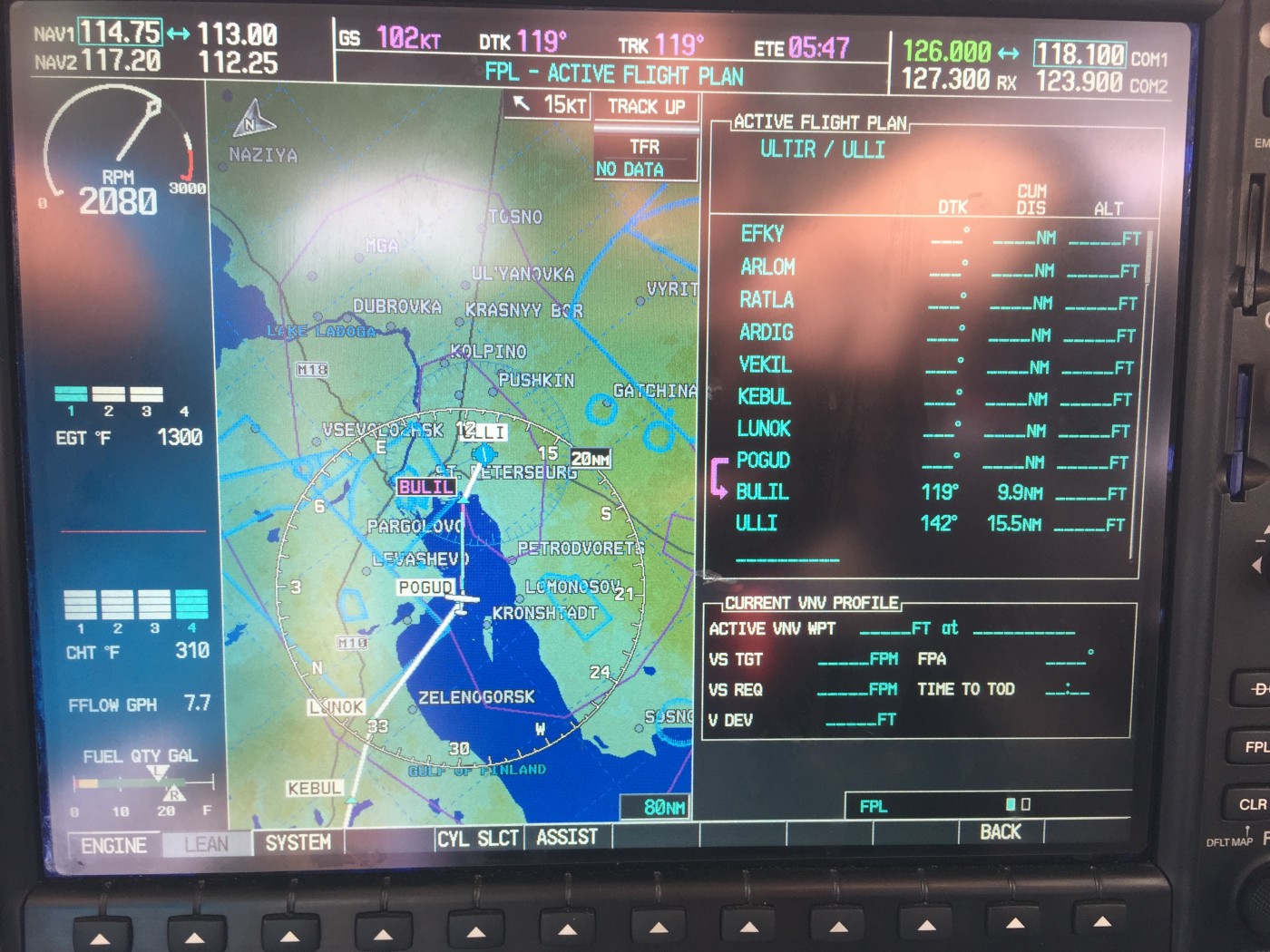
Flight plan EFKY-ULLI
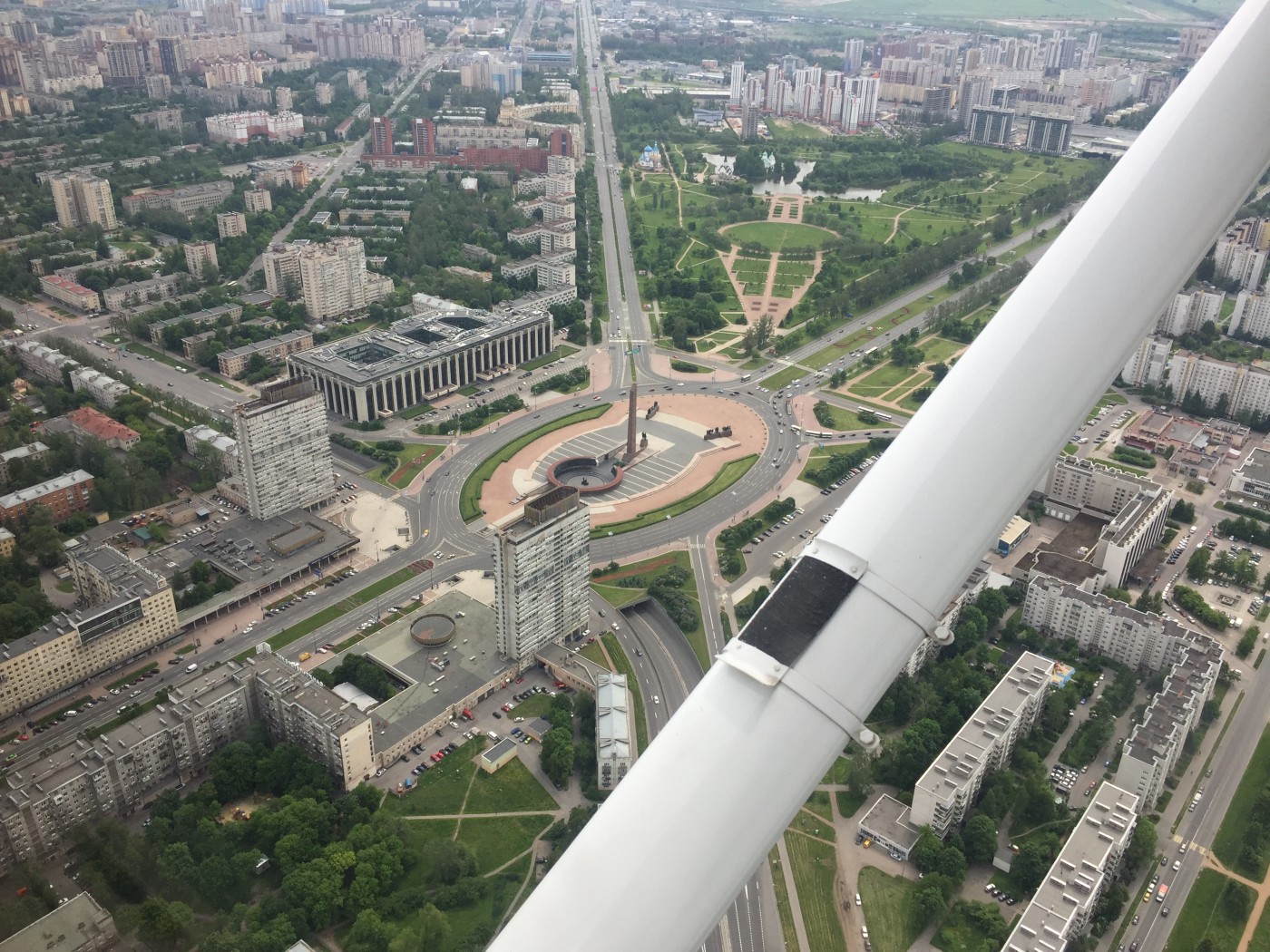
Holding in Pulkovo vicinity
Despite some challenges on border transition and marginal weather, all participants landed on the assigned slots at ULLI and the ground services were waiting for us at dedicated apron.
(I have the entire radio exchange recorded, should someone’s interested)
Immediately upon landing we were surrounded by border agents; up to two per airplane. They asked for the forms of General Declaration. Than appeared a guy from S7 Airlines and he saved our day. Misfiled forms caused delays, and for Russian Passport control it does really mater whether person is a crewmember or a passenger! We spend 2 hours to process our group of 25+ people and finally got to the city.

Crew bus kindly provided by ULLI
All airplanes flew VFR, except PC12 which was IFR. (Such a waste — it would be wonderful to watch N-registered gray airplane crossing Russian border @ 2000')
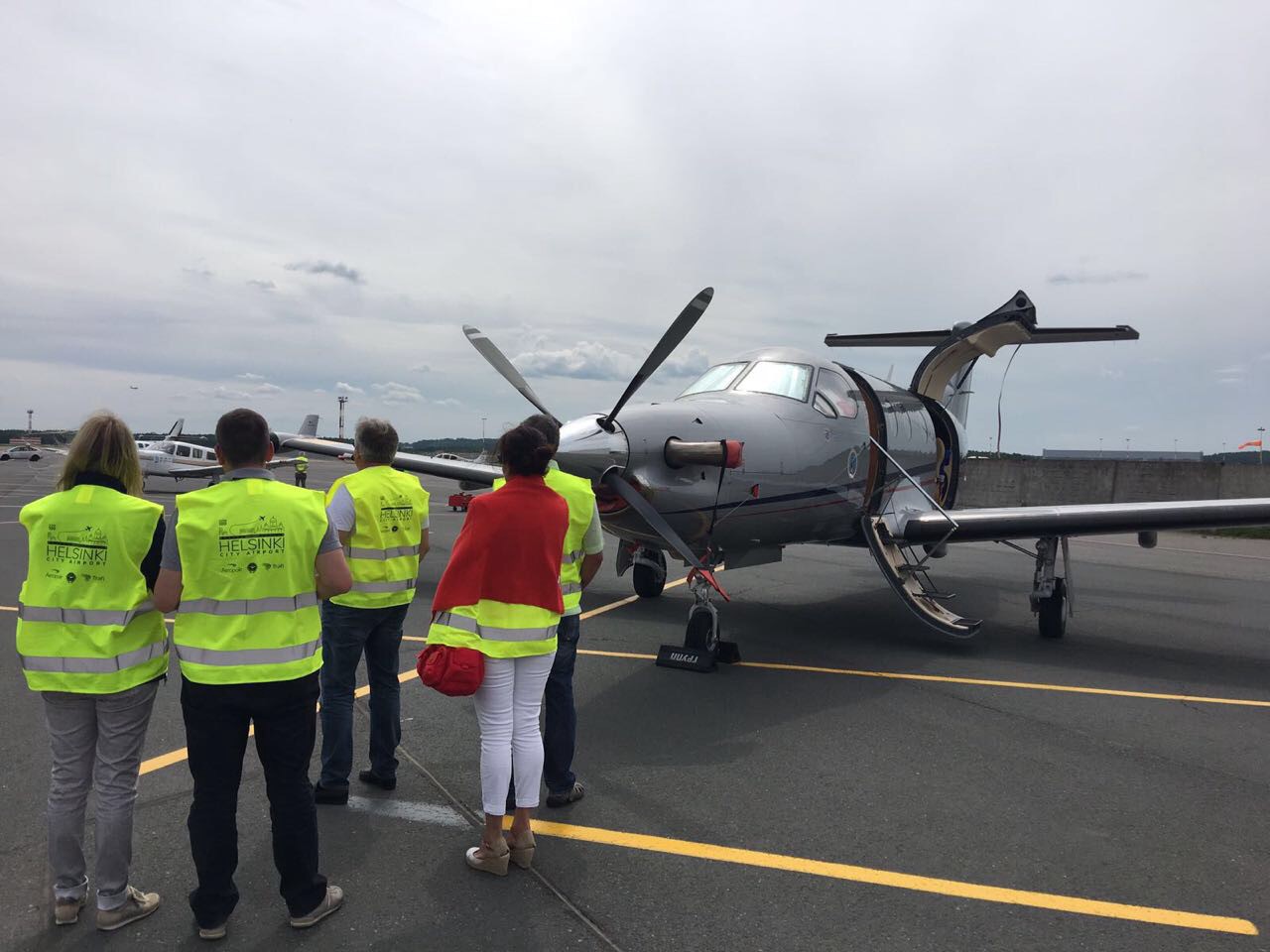
In the city we had an official reception and a press conference. And a party [DATA EXPUNGED].

The Peter and Paul Fortress
June 21, day seven
Pulkovo ULLI to Tallinn EETN to Kuuresaare EEKE
The crew from Estonia departed a day earlier and run through several complications. There is no full integration between Russian Filing System and the EuroControl one and therefore there were multiple human factor errors, including the wrongfully assigned and filed route. It turned out that Russian ATC somehow accepted a wrong flight plan — with waypoints outside of allowed route (In Russia no foreign registered aircraft is allowed to fly outside the specific routes). Pulkovo Tower was unable to locate proper flight plan for Estonian crew and due to language constraints the actual departure was delayed for few hours. Bad weather, strong head wind and no re-fuel in ULLI forced Estonian crew to fly low altitude and constantly control their fuel burn to get to Tallinn safely.
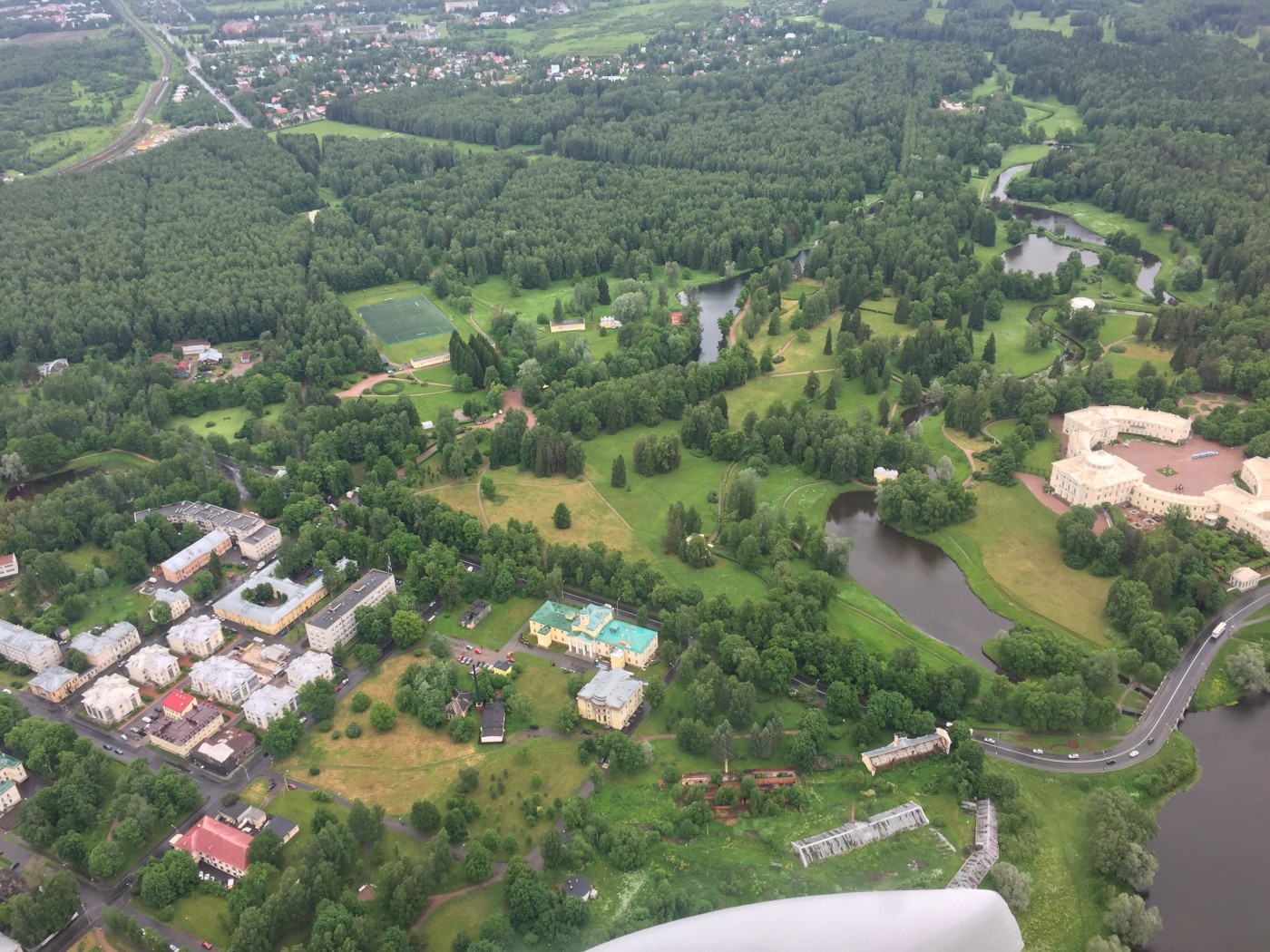
One of the vacuous delays we faced (though not only in Russia but in all countries with underdeveloped GA regulations) is passport control clearance: ordinary officers have no idea how to handle private pilots and their passengers because none of us had a boarding pass so they simply refused the clearance. Eventually a boss of the airport bosses decided that to use a copy of a general declaration as a boarding pass seemed to be sufficient; so they put a custom stamp on our GDs and we were done.
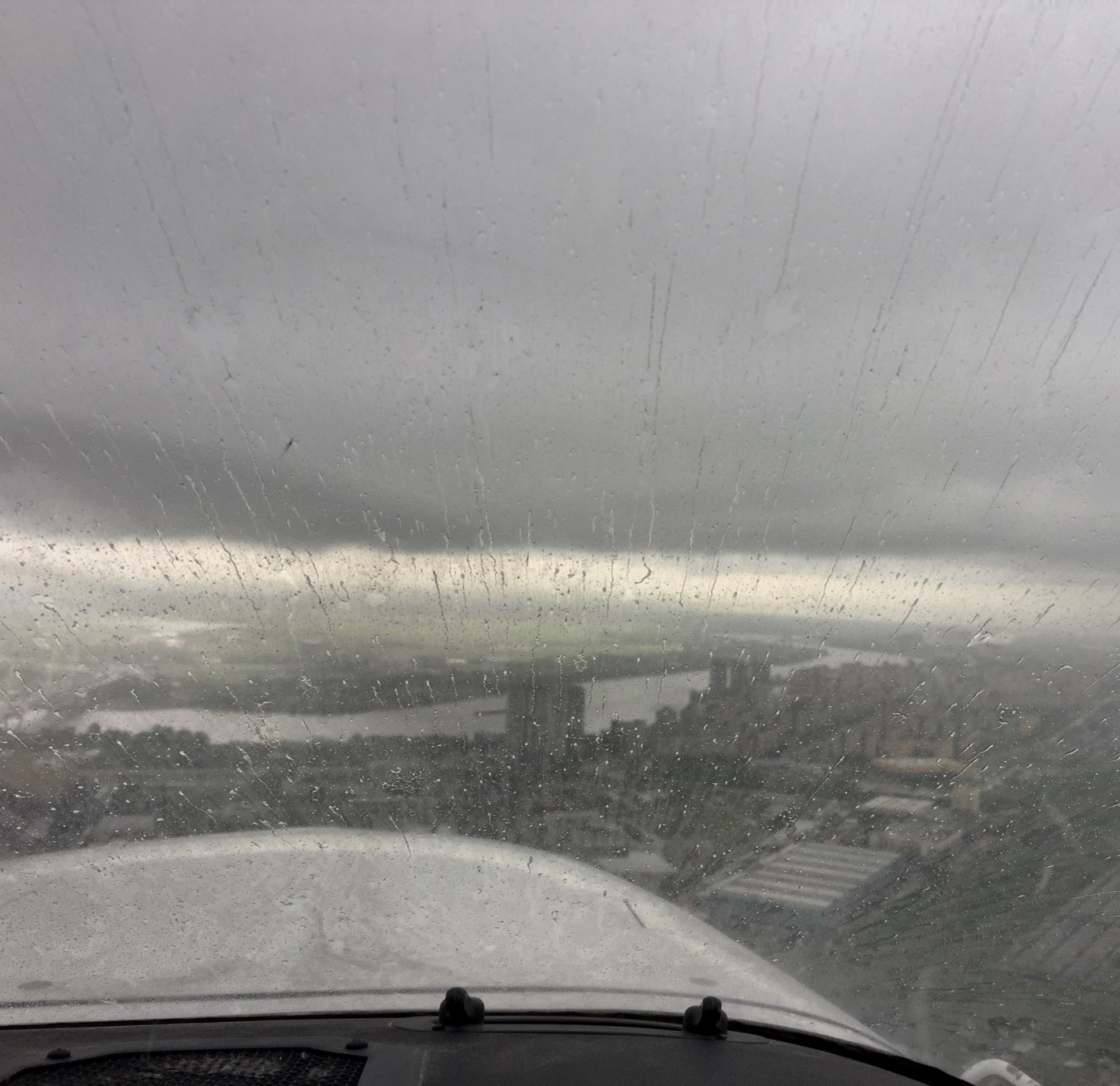
Farewell Saint Petersburg
The only remaining problem was the weather: severe rain with 1000’ ceiling. We departed and flew 1000' almost in low ceiling of plumb clouds, in rain. It was bumpy but no TS. The bad weather persisted along the whole route to Russian border. Once we crossed the border (RANVA) the weather instantly got better!

Crossed the border
Except for quite an expensive avgas (€2.7/l), other fees are reasonable for an international airport (€70 for landing, handling and a crew car). I was delighted to find L-39s of Breitling team there.
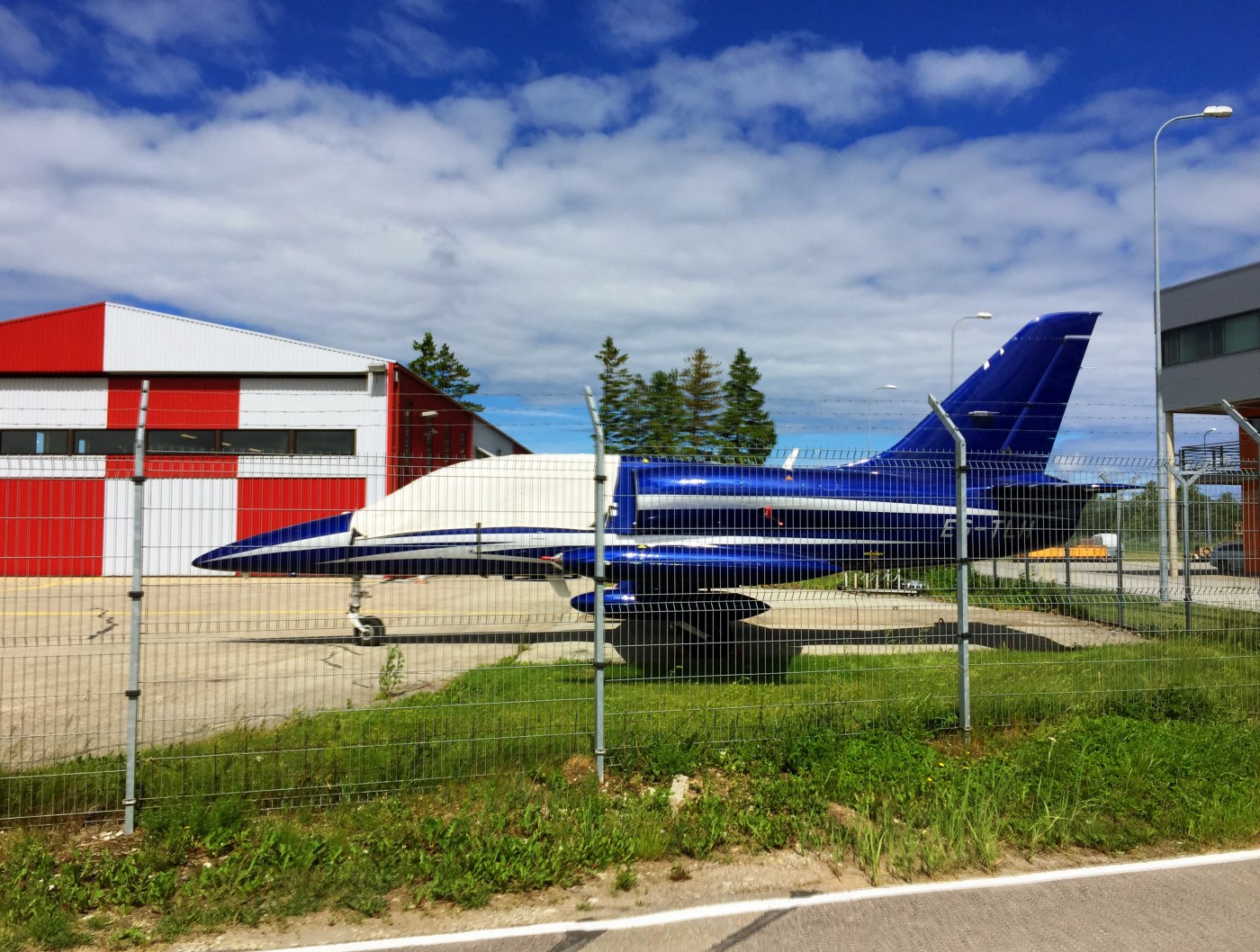
After a reunion with our group and quick lunch we departed to Saaremaa island, Kuuresaare (EEKE).

(Embed xwind https://www.youtube.com/watch?v=JMTYnmUfAoE&feature=emb_title)
June 22, day eight
Kuuresaare EEKE to Gdansk EPGD
Kuuresaare is a quiet nice city. We liked it and decided to stay for 2 nights. Finally we had a chance to do some stuff of our own: to work. In the evening the rest of our group caught up.
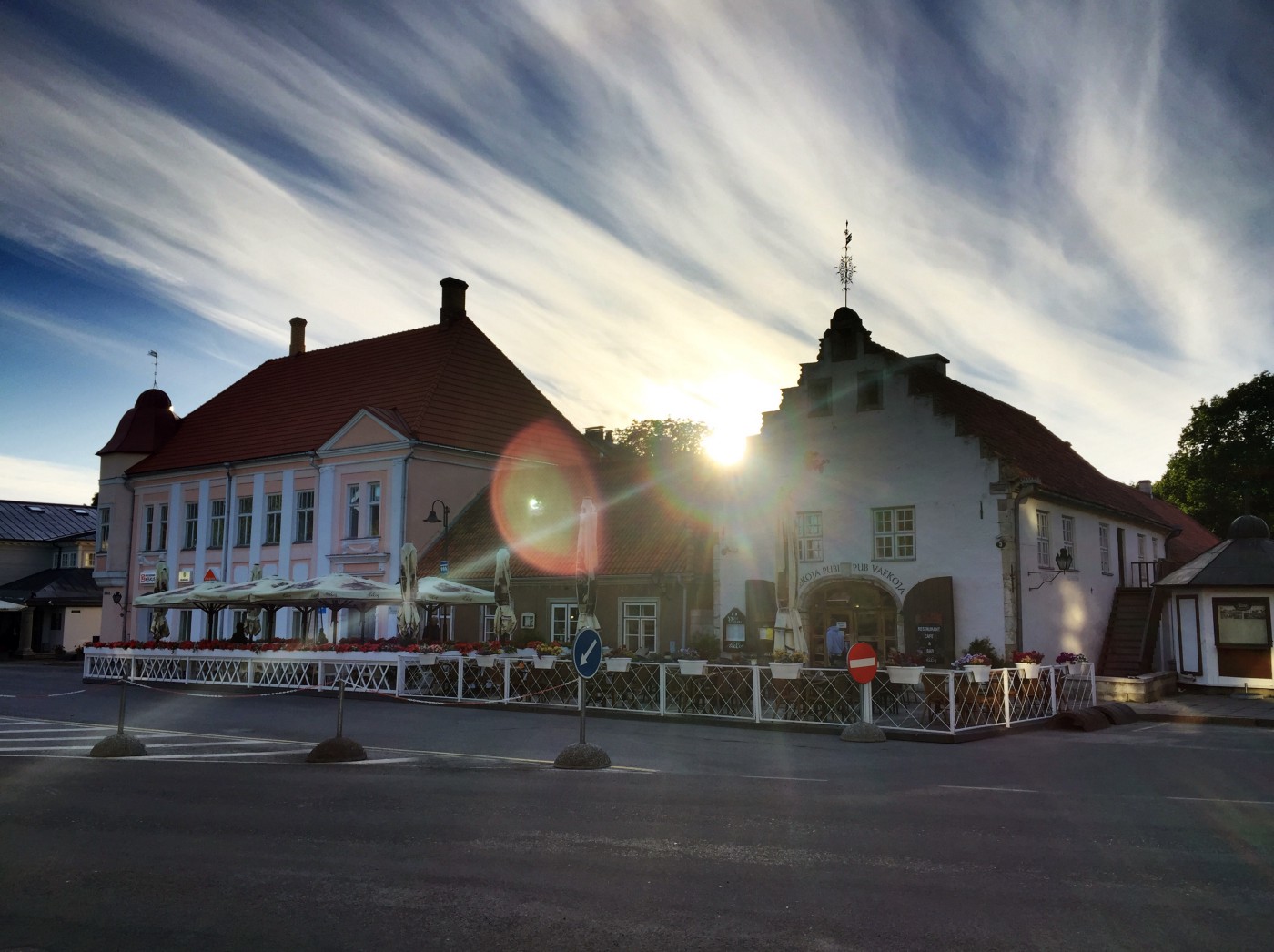
We found out that our meeting with President Lech Walensa in Gdansk, originally planned for 24th, now had been re-scheduled for 23rd; therefore we had to re-arrange our flight plans. Moreover, there was a weather system moving from the east (Berlin) to Gdansk. T-storms and heavy rain were likely expected in the morning of 23rd in Gdansk.
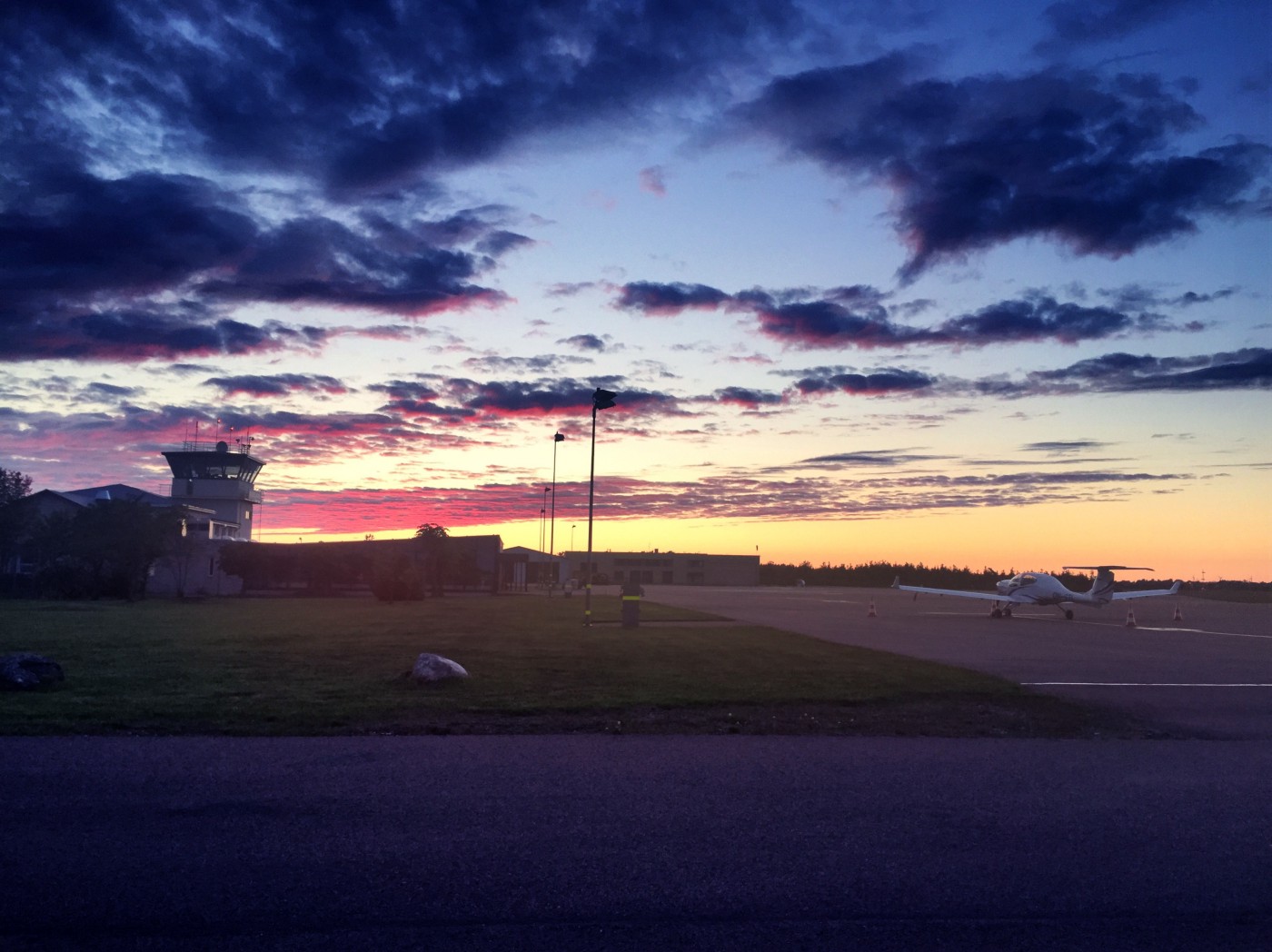
Ready to depart
To eliminate this pressure we decided to depart at midnight and fly night VFR over the Baltic Sea. Well, a night of June 22nd was the shortest one in the whole year in that area, about 2 hours!
(Embed night VFR from Kuur https://www.youtube.com/watch?v=wNoMOM8DJvQ)
The flight was calm; we stayed below 4000’ to prevent getting to IMC and icing conditions. FEW clouds below didn’t prevent us from seeing ship’s lights in Baltic sea. We avoided Russian airspace (Kaliningrad) and approached Gdansk.
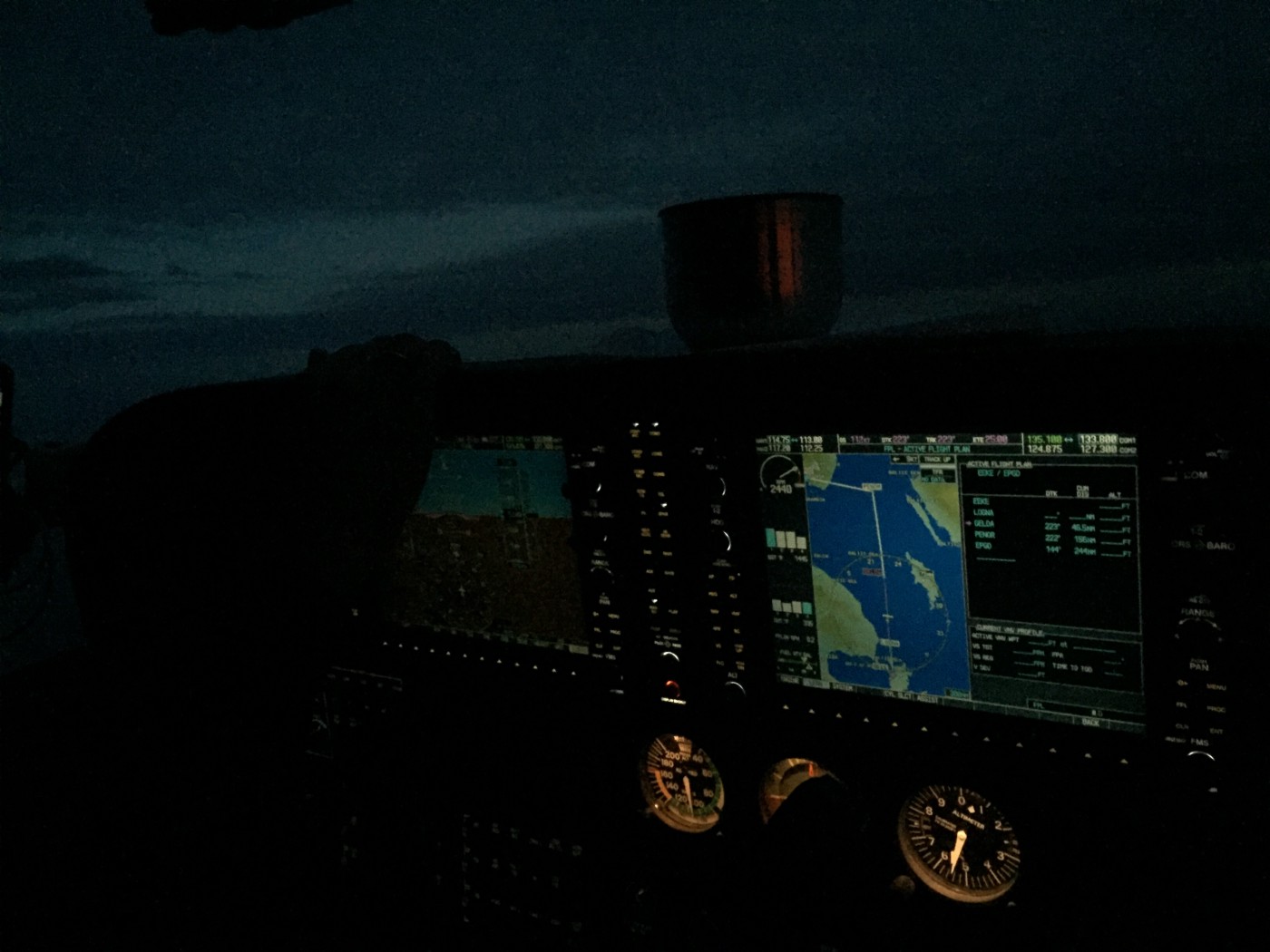
Polish control was very kind and helpful. And by the way, you don’t need a PPR in Gdansk! We managed to get a few hours of sleep in a motel close to the airport.
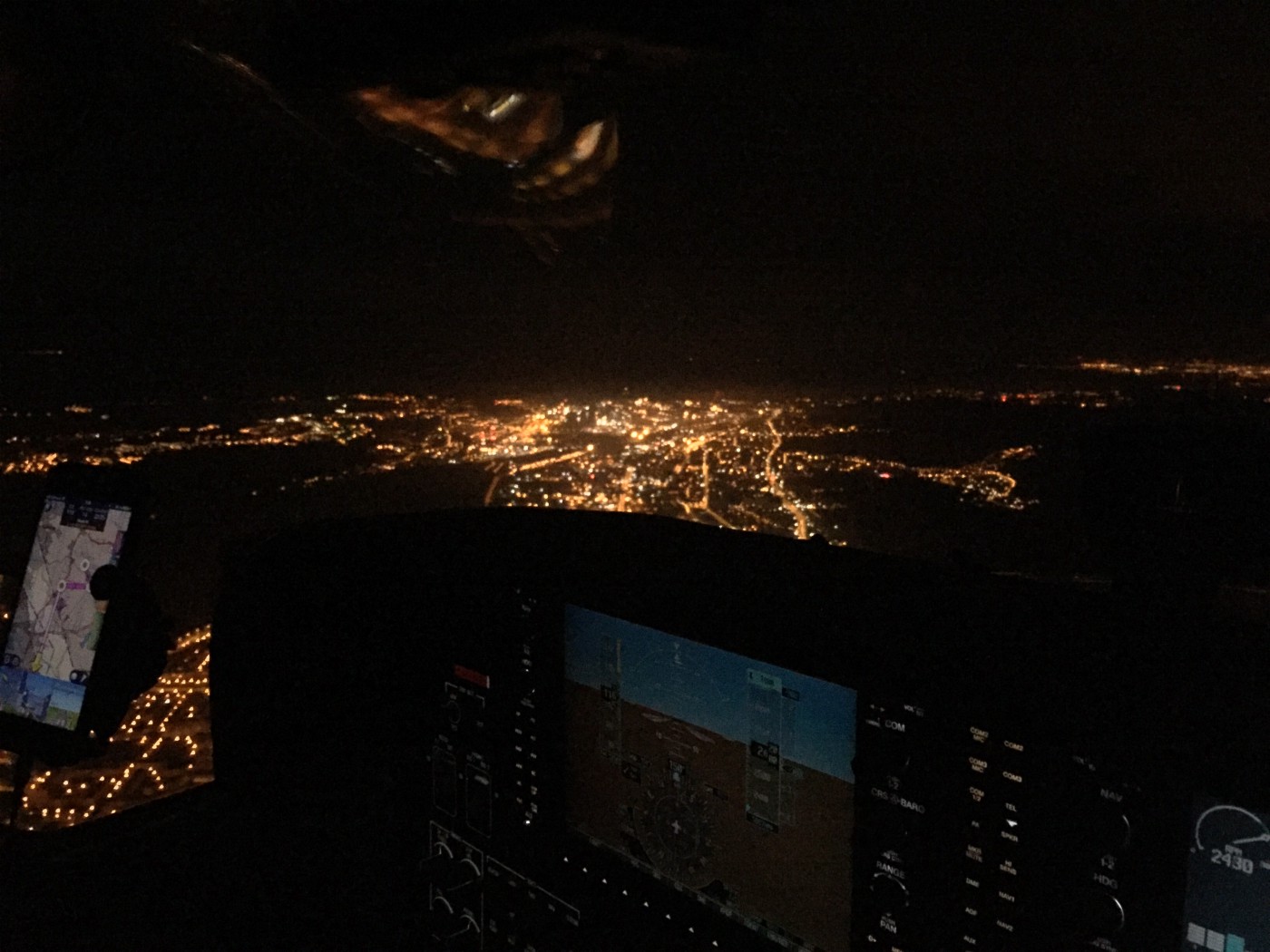
Approaching Gdansk
June 23, day nine
Gdansk EPGD to Porta Westfalica EDVY to Luxembourg ELLX
Though at 8am on the 23rd the weather was not that bad in Gdansk despite the forecast, it was a good decision to fly overnight; we score a nice night VFR refresher. We met with our rally members (who arrived at 9am) and proceeded to Gdansk city center, to Solidarnost museum center where our group met with Lech Walesa.
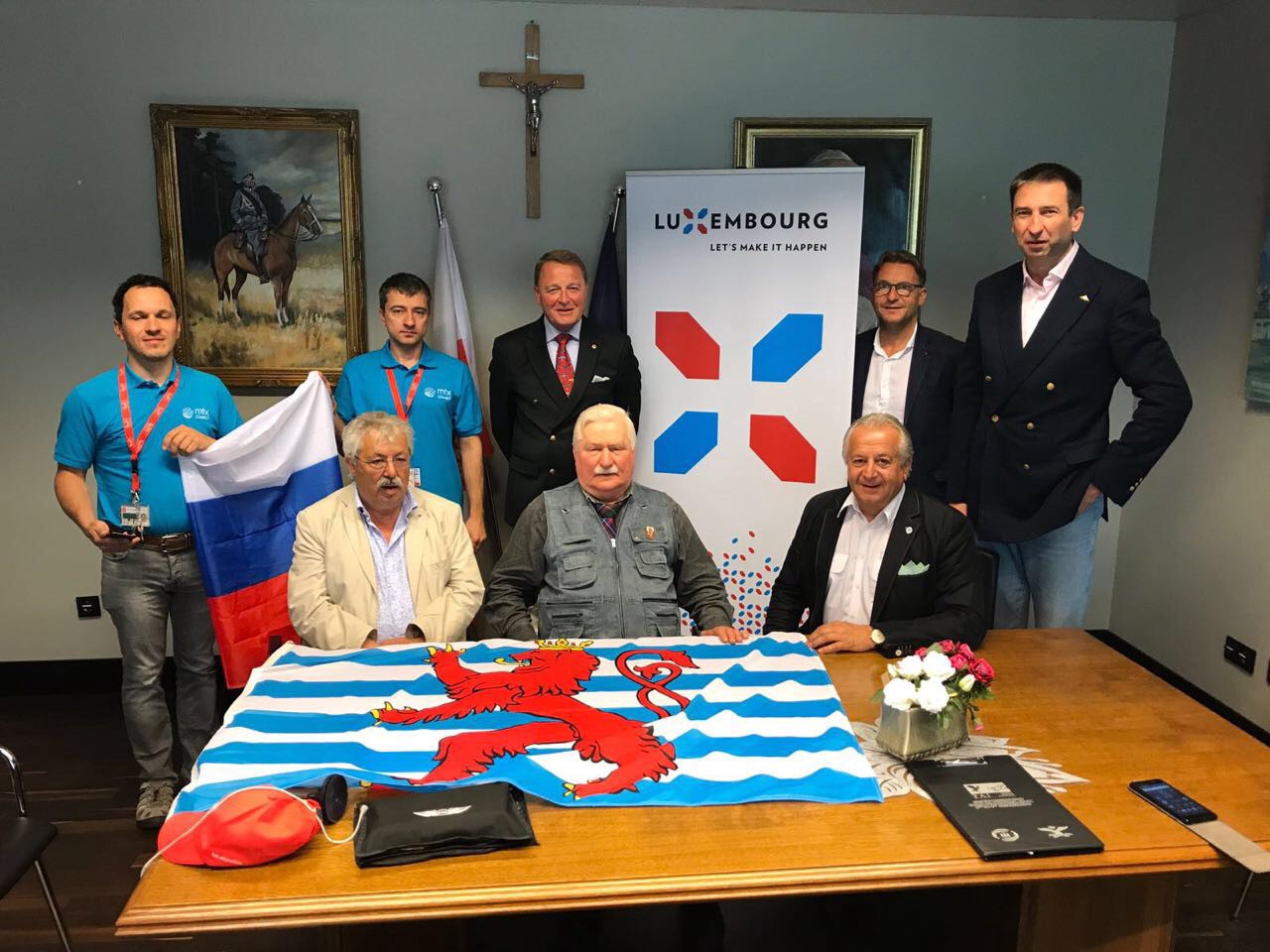
Lech Walesa office
Now the rally was over. Some crews stayed in Gdansk and flew to Kaunas on the next day. Our crew decided to skip Kaunas and to return home. At EPGD we refueled (€1.8/l) paid fees and proceeded to Luxembourg ELLX via Porta Westfalica.
… Headwinds and layers slowed us down to our home flight. We crossed Poland, the Czech Republic and entered Germany. After Hamburg the weather got better, just some scattered clouds.

Porta Westfalica
We landed at Porta Westfalica, refueled, ate a currywurst and went direct to Luxembourg ELLX.
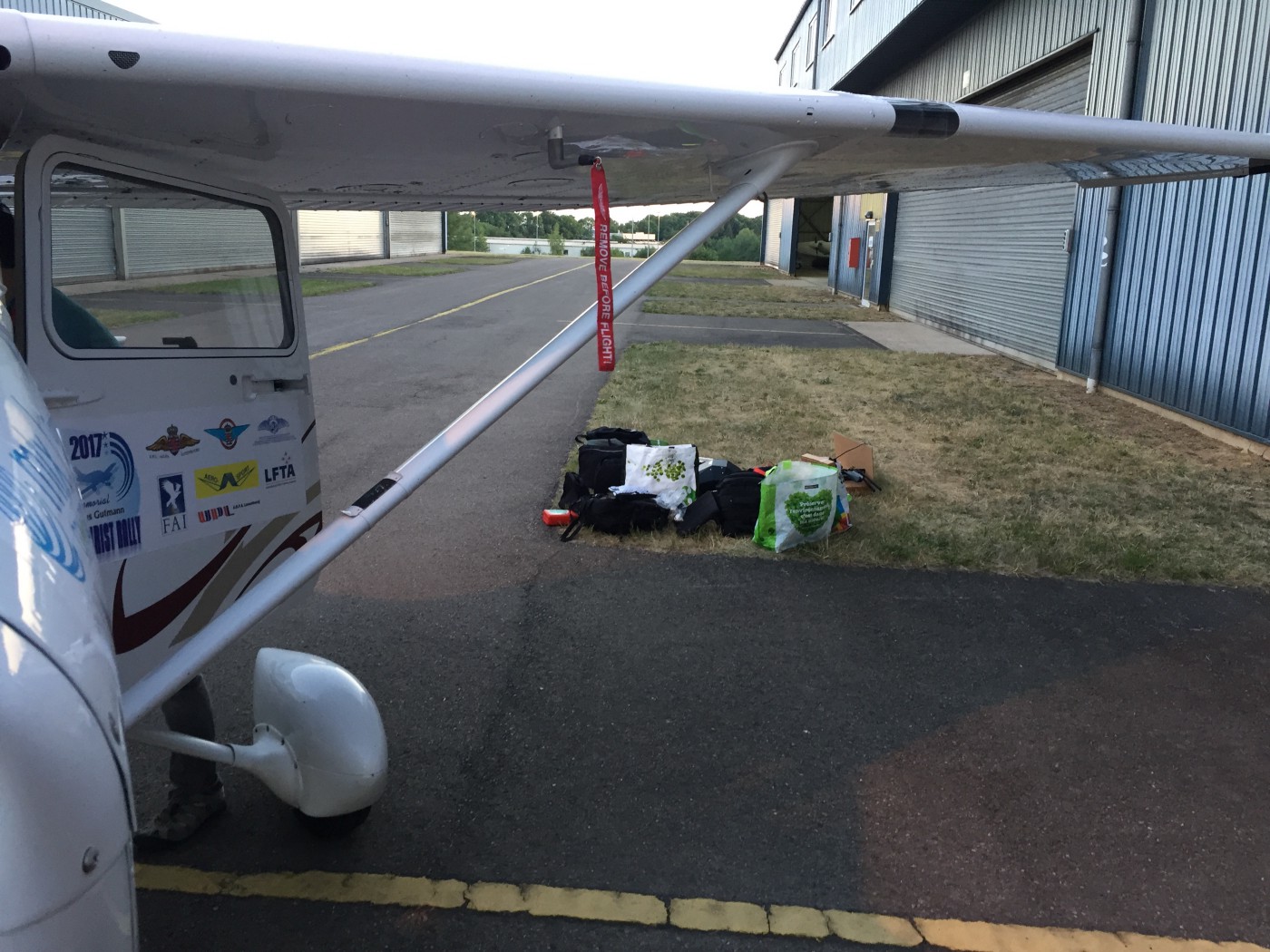
Taking out our luggage and parking the airplane
Conclusion
Nobody had any significant complications except one crew who had issues with starter and was grounded for few days at Kaunas. Total flying time on C172SP was ca. 30 hrs. 3100 NM in 7 days flying. We had a diverse fleet this year with types ranging from Cessna 172SP to Pilatus PC12. We received a great support from the Embassy of Luxembourg in Moscow. Russian AOPA also did a great job helping us with permissions and flight plans. S7 Airlines aided a lot in Pulkovo. VFR cross-border flights are possible in Russia. We even managed to get permit for the more complicated route (Saint Petersburg — Velikiy Novgorod — Pskov), but due to time constraint and touristic nature of the rally we decided to skip. General advise would be not to fly to Russia next year before July 15 due to elevated security measures associated with FIFA World Cup 2018.
Written by
l4rz